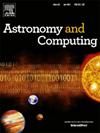Survey-wide asteroid discovery with a high-performance computing enabled non-linear digital tracking framework
IF 1.8
4区 物理与天体物理
Q2 ASTRONOMY & ASTROPHYSICS
引用次数: 0
Abstract
Modern astronomical surveys detect asteroids by linking together their appearances across multiple images taken over time. This approach faces limitations in detecting faint asteroids and handling the computational complexity of trajectory linking. We present a novel method that adapts “digital tracking” – traditionally used for short-term linear asteroid motion across images – to work with large-scale synoptic surveys such as the Vera Rubin Observatory Legacy Survey of Space and Time (Rubin/LSST). Our approach combines hundreds of sparse observations of individual asteroids across their non-linear orbital paths to enhance detection sensitivity by several magnitudes. To address the computational challenges of processing massive data sets and dense orbital phase spaces, we developed a specialized high-performance computing architecture. We demonstrate the effectiveness of our method through experiments that take advantage of the extensive computational resources at Lawrence Livermore National Laboratory. This work enables the detection of significantly fainter asteroids in existing and future survey data, potentially increasing the observable asteroid population by orders of magnitude across different orbital families, from near-Earth objects (NEOs) to Kuiper belt objects (KBOs).
用高性能计算支持的非线性数字跟踪框架进行全范围的小行星发现
现代天文调查通过将它们的外观与随时间拍摄的多幅图像联系起来来探测小行星。这种方法在探测微弱小行星和处理轨迹连接的计算复杂性方面存在局限性。我们提出了一种新的方法,将“数字跟踪”——传统上用于小行星在图像上的短期线性运动——用于大规模的天气调查,如维拉鲁宾天文台时空遗产调查(Rubin/LSST)。我们的方法结合了对单个小行星在其非线性轨道路径上的数百次稀疏观测,以提高几个数量级的探测灵敏度。为了解决处理大量数据集和密集轨道相位空间的计算挑战,我们开发了一种专门的高性能计算架构。我们通过利用劳伦斯利弗莫尔国家实验室广泛的计算资源的实验证明了我们方法的有效性。这项工作能够在现有和未来的调查数据中检测到明显较暗的小行星,潜在地增加了不同轨道家族的可观测小行星数量,从近地天体(NEOs)到柯伊伯带天体(kbo)。
本文章由计算机程序翻译,如有差异,请以英文原文为准。
求助全文
约1分钟内获得全文
求助全文
来源期刊

Astronomy and Computing
ASTRONOMY & ASTROPHYSICSCOMPUTER SCIENCE,-COMPUTER SCIENCE, INTERDISCIPLINARY APPLICATIONS
CiteScore
4.10
自引率
8.00%
发文量
67
期刊介绍:
Astronomy and Computing is a peer-reviewed journal that focuses on the broad area between astronomy, computer science and information technology. The journal aims to publish the work of scientists and (software) engineers in all aspects of astronomical computing, including the collection, analysis, reduction, visualisation, preservation and dissemination of data, and the development of astronomical software and simulations. The journal covers applications for academic computer science techniques to astronomy, as well as novel applications of information technologies within astronomy.
 求助内容:
求助内容: 应助结果提醒方式:
应助结果提醒方式:


